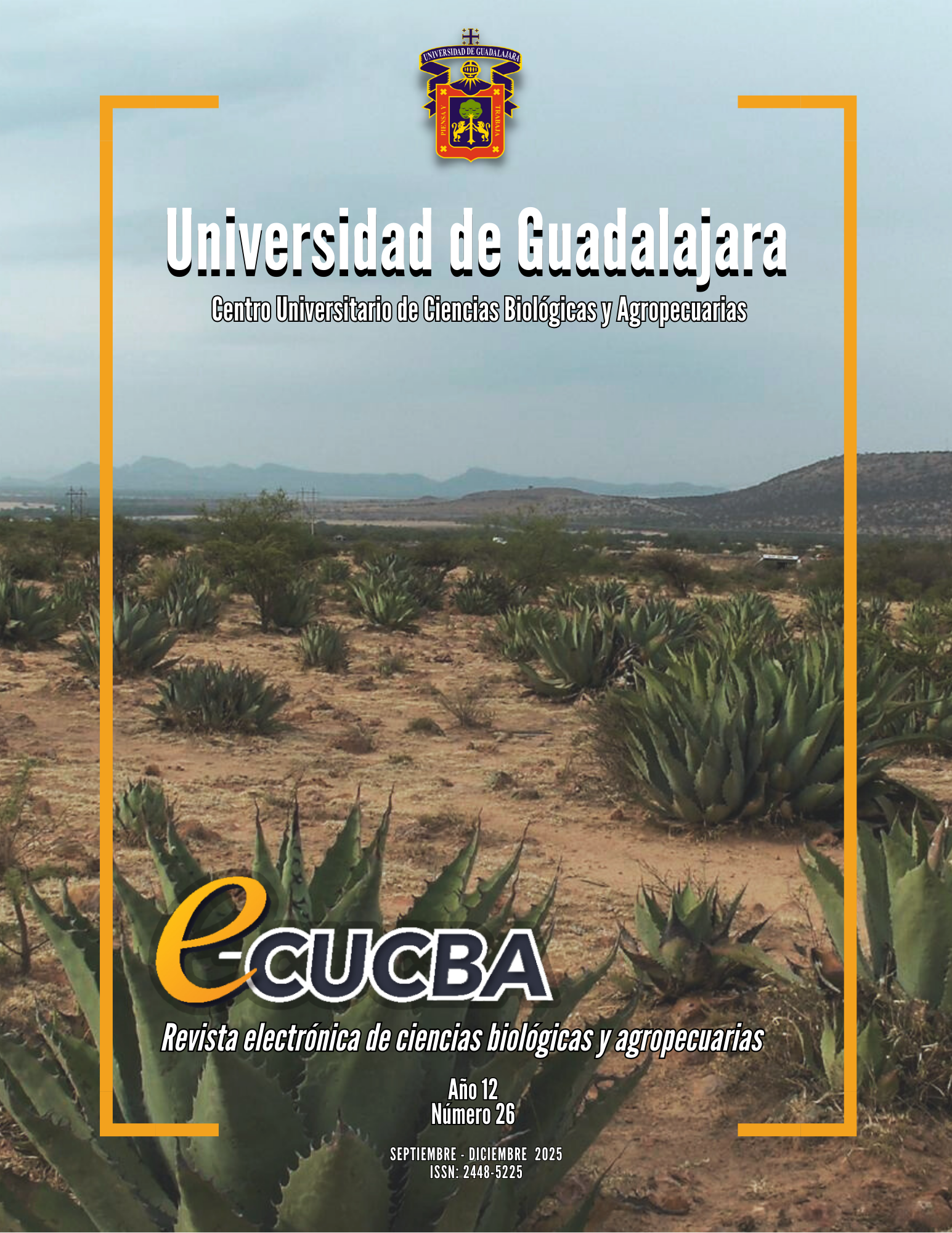Tendencias en la investigación de bosques urbanos en México: Una revisión de la literatura
Trends in urban forest research in Mexico: A literature review
DOI:
https://doi.org/10.32870/e-cucba.vi26.395Palabras clave:
Arbolado urbano, áreas verdes urbanas, cambio climático, servicios ecositémicos urbanos, sostenibilidad, urbanizaciónResumen
Los objetivos de este estudio fueron: i) analizar las investigaciones de manera cronológica por período de publicación, ii) identificar las entidades federativas con mayor número de publicaciones, iii) clasificar las publicaciones por contexto, tema de estudio, escala, unidad de análisis, tipo de método y método de estudio, iv) conocer las tendencias actuales en la investigación sobre bosques urbanos en México, e v) identificar las oportunidades futuras de investigación sobre bosques urbanos en el país. Para la selección de los estudios se utilizó el método PRISMA 2020. Se identificaron 198 publicaciones, de las cuales 170 fueron incluidas en el análisis. Los estudios se publicaron entre 1996 y 2023 y se realizaron en 23 de las 32 entidades federativas, concentrándose una tercera parte en la Ciudad de México (31.76 %). La mayoría se enfocaron en un contexto “ecológico” (62.76 %). En cuanto a la escala, predominaron los estudios en “bosques urbanos” (88.24 %), y el método más empleado fue el “biofísico” (87.06 %).
La investigación en este campo mostró un crecimiento sostenido (y particularmente exponencial en los últimos años), impulsado por la creciente percepción de los bosques urbanos como aliados clave para enfrentar el cambio climático y avanzar hacia la sostenibilidad y resiliencia urbana.
Citas
Baumgardner, D., Varela, S., Escobedo, F. J., Chacalo, A., y Ochoa, C. (2012). The role of a peri-urban forest on air quality improvement in the Mexico City megalopolis. Environmental Pollution, 163, 174-183. https://doi.org/10.1016/j.envpol.2011.12.016
Bentsen, P., Lindholst, A. C., y Konijnendijk, C. C. (2010). Reviewing eight years of Urban Forestry & Urban Greening: Taking stock, looking ahead. Urban Forestry & Urban Greening, 9(4), 273-280. https://doi.org/10.1016/j.ufug.2010.06.003
Bolund, P., y Hunhammar, S. (1999). Ecosystem services in urban areas. Ecological Economics, 29(2), 293-301. https://doi.org/10.1016/S0921-8009(99)00013-0
Boulton, C., Dedekorkut-Howes, A., y Byrne, J. (2018). Factors shaping urban greenspace provision: A systematic review of the literature. Landscape and Urban Planning, 178, 82-101. https://doi.org/10.1016/j.landurbplan.2018.05.029
Byrne, J., Sipe, N., y Searle, G. (2010). Green around the gills? The challenge of density for urban greenspace planning in SEQ. Australian Planner, 47(3), 162–177. https://doi.org/10.1080/07293682.2010.508204
Carreño-Campo, C., y Alfonso, W. H. (2018). Relación entre los procesos de urbanización, el comercio internacional y su incidencia en la sostenibilidad urbana. Cuadernos de Vivienda y Urbanismo, 11(22), 1-29. https://doi.org/10.11144/Javeriana.cvu11-21.rpuc
Cortinovis, C., y Geneletti, D. (2019). A framework to explore the effects or urban planning decisions on regulating ecosystem services in cites. Ecosystem Services, 38, 100946. https://doi.org/10.1016/J.ECOSER.2019.100946
De Groot, R. S., Alkemade, R., Braat, L., Hein, L., y Willemen, L. (2010). Challenges in integrating the concept of ecosystem services and values in landscape planning, management and decision making. Ecological Complexity, 7(3), 260-272. https://doi.org/10.1016/j.ecocom.2009.10.006
De Stefano, S., y Deblinger, R. D. (2005). Wildlife as valuable natural resources vs. intolerable pests: a suburban wildlife management model. Urban Ecosystems, 8(2), 179–190. https://doi.org/10.1007/s11252-005-4379-5
Dobbs, C., Escobedo, F. J., y Zipperer, W. C. (2011). A framework for developing urban forest ecosystem services and goods indicators. Landscape and Urban Planning, 99, 196-206. https://doi.org/10.1016/j.landurbplan.2010.11.004
Dobbs, C., Escobedo, F. J., Clerici, N., De la Barrera, F., Eleuterio, A. A., MacGregor-Fors, I., Reyes-Paecke, S., Vásquez, A., Zea-Camaño, J. D., y Hernández, H. J. (2019). Urban ecosystem Services in Latin America: mismatch between global concepts and regional realities? Urban Ecosystems, 22, 173–187. https://doi.org/10.1007/s11252-018-0805-3
Food and Agriculture Organization of the United Nations. (2016). Guidelines on urban and peri-urban forestry. https://www.fao.org/3a-i6210e.pdf
Gómez-Baggethun, E., y Barton, D. N. (2013). Classifying and valuing ecosystem services for urban planning. Ecological Economics, 86, 235-245. https://doi.org/10.1016/j.ecolecon.2012.08.019
Haase, D., Larondelle, N., Andersson, E., Artmann, M., Borgström, S., Breuste, J., Gomez-Baggethun, E., Gren, Å., Hamstead, Z., Hansen, R., Kabisch, N., Kremer, P., Langemeyer, J., Rall, E. L., McPhearson, T., Pauleit, S., Qureshi, S., Schwarz, N., Voigt, A., Wurster, D., y Elmqvist, T. (2014). A Quantitative Review of Urban Ecosystem Service Assessments: Concepts, Models, and Implementation. AMBIO, 43(4), 413–433. https://doi.org/10.1007/s13280-014-0504-0
Instituto Nacional de Estadística y Geografía. (2022). Principales resultados del censo de población y vivienda 2020. https://www.inegi.org.mx/contenidos/productos/prod_serv/contenidos/espanol/bvinegi/productos/nueva_estruc/702825198060.pdf
Jorgensen, A., y Anthopoulou, A. (2007). Enjoyment and fear in urban woodlands-does age make a difference? Urban Forestry & Urban Greening, 6(4), 267–278. https://doi.org/10.1016/j.ufug.2007.05.004
Kang, W., Chon, J., y Kim, G. (2020). Urban Ecosystem Services: A Review of the Knowledge Components and Evolution in the 2010s. Sustainability, 12(23). https://doi.org/10.3390/su12239839
Leal-Elizondo, C. E., Leal-Elizondo, N. Alanís-Rodríguez, E. Pequeño-Ledezma, M. A., Mora-Olivo, A., y Buendía-Rodríguez, E. (2018). Estructura, composición y diversidad del arbolado urbano de Linares, Nuevo León. Revista Mexicana de Ciencias Forestales, 9(48), 252-270. https://doi.org/10.29298/rmcf.v8i48.129
Luederitz, C., Brink, E., Gralla, F., Hermelingmeier, V., Meyer, M., Niven, L., Panzer, L., Partelow, S., Rau, A-L., Sasaki, R., Abson, D. J., Lang, D. J., Wamsler, C., y Von Wehrden, H. (2015). A review of urban ecosystem services: six key challenges for future research. Ecosystem Services, 14, 98-112. https://doi.org/10.1016/j.ecoser.2015.05.001
Martínez-Rodríguez, M. C. y Cervantes-Nájera, A. L. (2023). La conexión de las personas con las áreas verdes urbanas. Una revisión de la literatura. Revista Investigium IRECiencias Sociales y Humanas, 14(1), 52-62. https://doi.org/10.15658/10.15658/INVESTIGIUMIRE.231401.05
Medrano-Pérez, O. R. (2020). Ciudades sobrecargadas: la sobreexplotación de recursos como limitante del desarrollo sustentable. Antípoda. Revista de Antropología y Arqueología, 1(39), 3-12. https://doi.org/10.7440/antipoda39.2020.01
Meza-Aguilar, M. C. (2015). Los árboles de la Ciudad de México. Guardianes de su imagen y calidad ambiental. Bitácora Arquitectura, 31, 96–102. https://doi.org/10.22201/fa.14058901p.2015.31.56652
Millennium Ecosystem Assessment. (2005). Ecosystems and human well-being: Synthesis. Island Press. https://www.millenniumassessment.org/documents/document.356.aspx.pdf
Ordóñez-Barona, C., Devisscher, T., Dobbs, C., Orozco-Aguilar, L., Dias-Baptista, M., Navarro, N. M., Ferreira-da Silva Filho, D., y Escobedo, F. J. (2020). Trends in Urban Forestry Research in Latin America & The Caribbean: A Systematic Literature Review and Synthesis. Urban Forestry & Urban Greening, 47, Artículo 126544. https://doi.org/10.1016/j.ufug.2019.126544
Page, M. J., McKenzie, J. E., Bossuyt, P. M., Boutron, I., Hoffmann, T. C., Mulrow, C. D., Shamseer, L., Tetzlaff, J. M., Akl, E. A., Brennan, S. E., Chou, R., Glanville, J., Grimshaw, J. M., Hróbjartsson, A., Lalu, M. M., Lin, T., Loder, E. W., Mayo-Wilson, E., McDonald, S., McGuinness, L. A., Stewart, L. A., Thomas, J., Tricco, A. C., Welch, V. A., Whiting, P., y Moher, D. Traductores: Yepes-Nuñez, J. J., Urrutia, G., Romero-García, M., y Alonso-Fernández, S. (2021). Declaración PRISMA 2020: una guía actualizada para la publicación de revisiones sistemáticas. Revista Española de Cardiología, 74(9), 790-799. https://doi.org/10.1016/j.recesp.2021.06.016
Pérez-Campuzano, E., Avila-Foucat, V. S., y Perevochtchikova, M. (2016). Environmental policies in the peri-urban area of Mexico City: The perceived effects of three environmental programs. Cities, 50, 129-136. https://doi.org/10.1016/j.cities.2015.08.013.
Raihan, A. (2023). A review on the role of green vegetation in improving urban environmental quality. Eco Cities, 4(2), Artículo 2387. https://doi.org/10.54517/ec.v4i2.2387
Robson, E., Van Kerkhoff, L., y Cork, S. (2019). Understanding citizen perceptions of the Eastern Hills of Bogota: a participatory place-based ecosystem service assessment. Urban Ecosystems, 22, 19–35. https://doi.org/10.1007/s11252-018-0739-9
Roy, S., Byrne, J., y Pickering, C. (2012). A systematic quantitative review of urban tree benefits, costs, and assessment methods across cities in different climatic zones. Urban Forestry & Urban Greening, 11(4), 351-363. https://doi.org/10.1016/j.ufug.2012.06.006
Rupprecht, C. D. D. y Byrne, J. A. (2014). Informal urban greenspace: A typology and trilingual systematic review of its role for urban residents and trends in the literature. Urban Forestry & Urban Greening, 13(4), 597-611. https://doi.org/10.1016/j.ufug.2014.09.002
United Nations, Department of Economic and Social Affairs, Population Division. (2015). World Urbanization Prospects: The 2014 Revision. https://www.un.org/development/desa/pd/sites/www.un.org.development.desa.pd/files/files/documents/2020/Oct/unpd_2014_wup-report.pdf
UN-Habitat. (2020). Reporte mundial de las ciudades 2020: El valor de la urbanización sostenible. Naciones Unidas. https://www.unhabitat.org
Semeraro, T., Scarano, A., Buccolieri, R., Santino, A. y Aarrevaara, E. (2021). Planning of Urban Green Spaces: An Ecological Perspective on Human Benefits. Land, 10(105), 1-25. https://doi.org/10.3390/land10020105
Zhao, X., Li, F., Yan, Y., y Zhang, Q. (2022). Biodiversity in Urban Green Space: A Bibliometric Review on the Current Research Field and Its Prospects. International Journal of Environmental Research and Public Health, 19(19), Artículo 12544. https://doi.org/10.3390/ijerph191912544
Zuñiga-Palacios, J., Zuria, I., Moreno, C. E., Almazán-Núñez, R. C., y González-Ledesma, M. (2020). Can small vacant lots become important reservoirs for birds in urban areas? A case study for a Latin American city. Urban Forestry & Urban Greening, 47, Artículo 126
Descargas
Publicado
Cómo citar
Número
Sección
Licencia
Derechos de autor 2025 María Cecilia Hernández-Cavazos, Eduardo Alanís-Rodríguez, Víctor Manuel Molina-Guerra, Javier Jiménez-Pérez, Oscar Alberto Aguirre-Calderón, Luis Gerardo Cuellar

Esta obra está bajo una licencia internacional Creative Commons Atribución-NoComercial-SinDerivadas 4.0.






